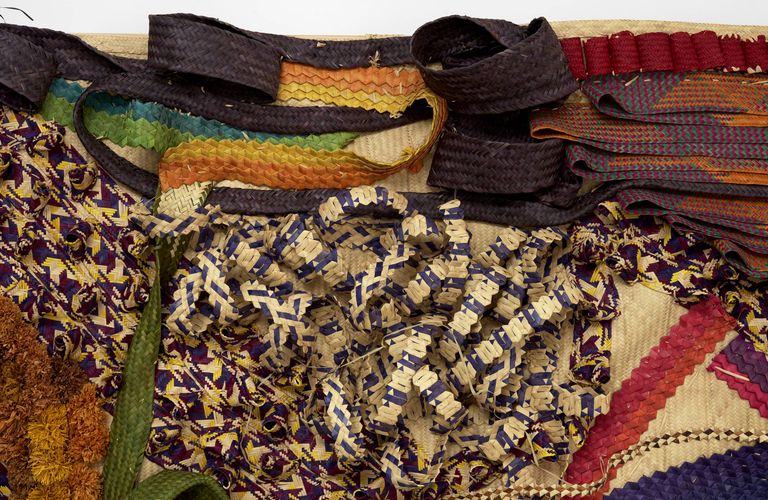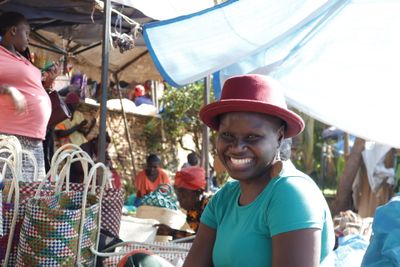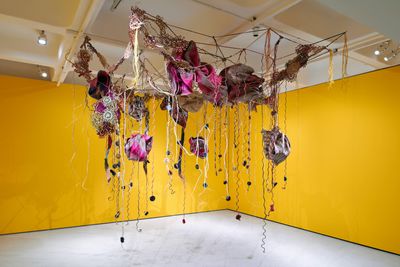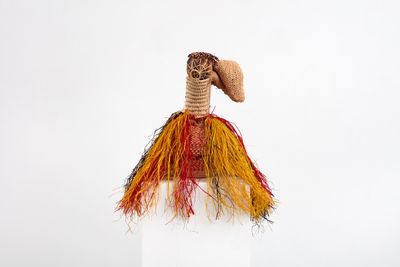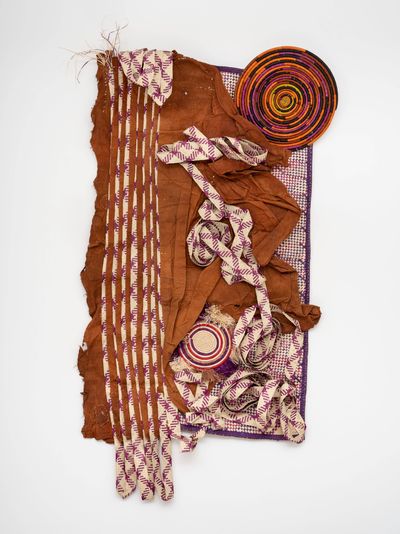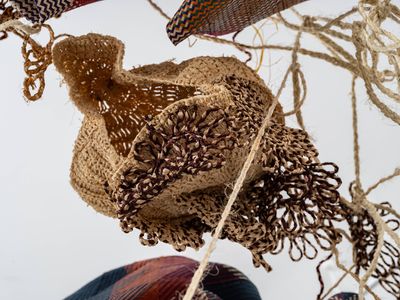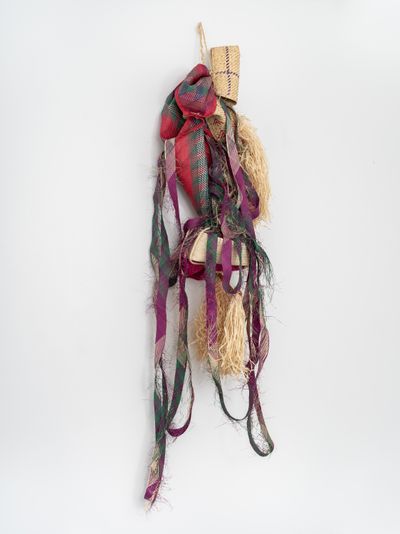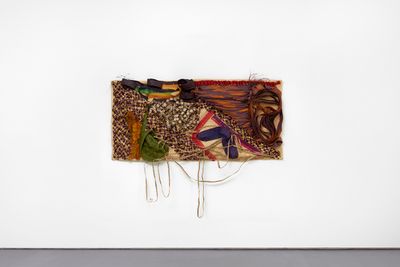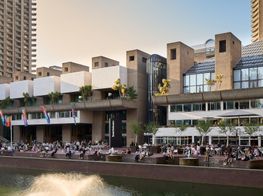Being the new kid on the block is a daunting prospect. This was Uganda at the 59th Venice Biennale in 2022. To fly the flag at the country's pavilion were two artists, Acaye Kerunen and Collin Sekajugo. And fly they did, awarded special mentions as National Participants 'in acknowledgement of their vision, ambition, and commitment to art and working in their country'.
For Venice Biennale's 60th, Kerunen returns. However, this time as curator of the Uganda Pavilion.
Ocula Director Eva Fuchs met with the performance artist, weaver, poet, and writer at the Barbican. In addition to Venice, Kerunen is one of 50 artists featured in Unravel: The Power and Politics of Textiles in Art at the London institution from 13 February to 26 May 2024.
Her contribution is Ayelele (2023), a large-scale sculpture made from raffia, stripped banana fibre, palm leaves, and sisal that have been weaved and knotted, and now hang suspended from Barbican's brutalist structure.
As the show opens, Kerunen speaks of reclaiming joy through sculpture, her return to Venice, and how she found a family in Pace Gallery.
Could you tell us about your work Ayelele (2023)? What does it mean to you?
Ayelele (2023) is a sound of elation, wonderment, or bewilderment. It can be an alarm for help or a celebration depending on the intonation and the situation around it.
Ayelele speaks to joy. Much of the time, joy has been relegated to a one-dimensional thing. But when we go back to our primary language and mode of expression, words and expressions have bigger meanings than the linear meaning that I'll find in the English language.
When the word Ayelele plays on the tongue, it is tantric in the sense that it awakens the somatic waves in the mind. It's a response to a couple of things that have happened in the past year, which should have just swept me under the radar, but the innate resilience, like natural textiles which have a life of their own, regenerates. And at the end of their use, you return them to nature where they dissolve and reintegrate.
So it's about reclaiming joy regardless of the circumstances or adversity that's surrounding us. And staying resolute, stoic, and dignified.
You began your creative career working in theatre, poetry, and performance. Was there a particular performance or play you worked on that you remember fondly?
I've always been that person who applies role-play. I've always created music around my experiences. I've always written poetry to respond to different modes of trauma and challenges.
I love choreography and movement. I like how body language speaks in very rich ways, more than words can. In Capoeira, the Brazilian martial art, brutal fighting moves are choreographed into dance. It's to find room for conversation. You find joy in capsules of conversation, which in most cases, will dissolve the conflict.
The plays I put on are extensions of myself and the conversations I wanted to have. The stage, whether it's in a gallery or a theatre, is my place to role-play the conversations I would rather have on my own terms.
This year, you will be curating the Uganda Pavilion at the Venice Biennale. What do you plan to bring to Venice?
My curation of the pavilion is intergenerational. I have artists from over 70 years old to just over 30 and it's focused on community. So I'm returning the sense of community of artists, but also a community of ways of achieving the same goal.
On one side are five artists who are all responding to each other. And on the other side, is a collective of 26 artisan women.
These artisans are libraries of knowledge with philosophies that underpin their making. Each are from different regions bringing different types of woven materials, products, and sculptures. I'm going to curate them in the pavilion and begin a taxonomical library saying: this basket is from this part of Uganda, which feeds into the Congo and Rwanda, and Burundi and Tanzania.
In many ways, the way Venice is curated means that one or two big artists represent a country. But I come from a country of over 44 languages and 68 dialects. We are a metropolis of humanity. We're one of the biggest hosts of refugees. And they are all fluid nations. They're Sudanese, Nubians, Egyptians, Eritreans, and Indians, and many more.
Before the borders were instituted by colonialism, we were a nation—a borderless blend to all these other places. And the library of women has kept that knowledge. In terms of patterns, colours, shapes, and also materiality. So the library of weaving is also installing this feminine knowledge that for the most part is undocumented.
The women are saying: this is my basket or this is my mat. I learned to weave like this from my mother or aunt who learned to weave from her grandmother, and these are the patterns from my life. This is why we love these patterns. It's why we chose these colours. And that's the library that's being instituted.
Looking at your work, it radiates positivity and joy, but you said that a lot of your work is about trauma. How does trauma influence your work and does making art have a cathartic effect on you?
My generation of African women carries the weight of inherited trauma from our maternal side. Trauma that we're living through, responding to, reacting to. But we also inherited a lot of strengths and gifts.
A huge side of the negative revolution of femininity is to disregard, do away, to try and erase how we are raised as females. But with that erasure comes a doing-away of the beauty of that phrasing as well.
So the juxtaposition with my works and the colours, forms, and shapes is both these things, like yin and yang. It's part of who I am. It's about finding the common thread within it all, which is beauty and joy.
My favourite artist, Louise Bourgeois, used textiles and sewing to attempt psychological repair. She said, 'I always had the fear of being separated and abandoned. Sewing is my attempt to keep things together and make things whole.' Does that resonate with you?
There is a lot of breaking, but also a lot of mending that is available in life if we are brave enough to take it. In that sense, no relationship is ever really dead. It's just waiting for us to reaffirm it when we're ready.
And because the same hand can also be a fist, a knife edge, a handshake, or a thumbs up. It's just how we use it with one another. There is always the possibility of renewal and repair.
I read that certain elements in your artworks represent an emotional experience. For example, knots 'are moments of respite to deposit a thought'. Can you expand on this?
Knots are boundaries for me. I'm returning to my childhood and intergenerational trauma where women are supposed to be these open septic soak pits of debris and sewage. And you've got to reach a point and say: Hello! I am the princess. I am the lady. I am the seductress. I am beautiful.
So the knot is not to deter, but to say: let's pause. Instead of walking over me, walk around me and get on by.
In one of your interviews, you said: 'Every time it rains, I get wet.' I love how connected you are to the world around you, acknowledging how emotionally and physically affected we are by our immediate environment, the weather, and so on.
How does that influence your art and everyday life?
It's just proclaiming my eroticism. To allow sensuality, it doesn't have to be a one-dimensional thing of coitus. It's also about tears. It's saliva. It's the rain on your skin. It's water to wash your hands and your body. It's boiling a pot of tea.
But it's also flooding. It's drowning. It's almost tempest. We are beings of water, all connected to liquid in a way. And the fluidity of life.
Wetness in many ways is also a mental wetting and moistening of the mind when it has reached a point of stasis and a return to the softness to mould again and anew.
In 2022, Pace Gallery announced your representation with a solo show in 2025. Last year you had your first solo exhibition in the U.S. with Blum & Poe (now BLUM). The past few years must have been a bit of a whirlwind. How's it gone?
I was initially quite apprehensive to join. In Venice in 2022, Pace Gallery's Marc Glimcher asked to meet me and responded to my concerns with understanding, empathy and recognition of historical disparities in the dominant art world. So it has been and continues to be a healthy and fluid conversation.—[O]
Main image: Acaye Kerunen, Wothu Matungtung (Different Movements) (2023) (detail). Raffia, hand dyed palm leaves. 160 x 200 cm x 15 cm. © Acaye Kerunen. Courtesy Pace Gallery.

